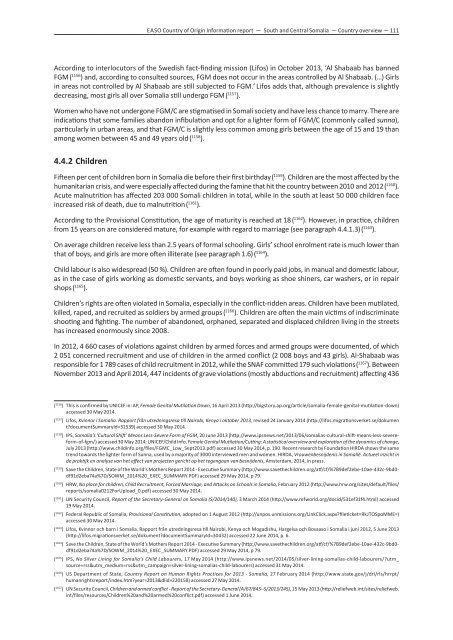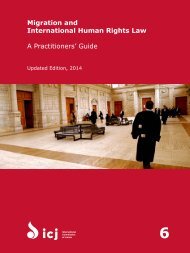You also want an ePaper? Increase the reach of your titles
YUMPU automatically turns print PDFs into web optimized ePapers that Google loves.
EASO Country of Origin Information report — South and Central <strong>Somalia</strong> — Country overview — 111<br />
According to interlocutors of the Swedish fact‐finding mission (Lifos) in October 2013, ‘Al Shabaab has banned<br />
FGM ( 1156 ) and, according to consulted sources, FGM does not occur in the areas controlled by Al Shabaab. (…) Girls<br />
in areas not controlled by Al Shabaab are still subjected to FGM.’ Lifos adds that, although prevalence is slightly<br />
decreasing, most girls all over <strong>Somalia</strong> still undergo FGM ( 1157 ).<br />
Women who have not undergone FGM/C are stigmatised in Somali society and have less chance to marry. There are<br />
indications that some families abandon infibulation and opt for a lighter form of FGM/C (commonly called sunna),<br />
particularly in urban areas, and that FGM/C is slightly less common among girls between the age of 15 and 19 than<br />
among women between 45 and 49 years old ( 1158 ).<br />
4.4.2 Children<br />
Fifteen per cent of children born in <strong>Somalia</strong> die before their first birthday ( 1159 ). Children are the most affected by the<br />
humanitarian crisis, and were especially affected during the famine that hit the country between 2010 and 2012 ( 1160 ).<br />
Acute malnutrition has affected 203 000 Somali children in total, while in the south at least 50 000 children face<br />
increased risk of death, due to malnutrition ( 1161 ).<br />
According to the Provisional Constitution, the age of maturity is reached at 18 ( 1162 ). However, in practice, children<br />
from 15 years on are considered mature, for example with regard to marriage (see paragraph 4.4.1.3) ( 1163 ).<br />
On average children receive less than 2.5 years of formal schooling. Girls’ school enrolment rate is much lower than<br />
that of boys, and girls are more often illiterate (see paragraph 1.6) ( 1164 ).<br />
Child labour is also widespread (50 %). Children are often found in poorly paid jobs, in manual and domestic labour,<br />
as in the case of girls working as domestic servants, and boys working as shoe shiners, car washers, or in repair<br />
shops ( 1165 ).<br />
Children’s rights are often violated in <strong>Somalia</strong>, especially in the conflict‐ridden areas. Children have been mutilated,<br />
killed, raped, and recruited as soldiers by armed groups ( 1166 ). Children are often the main victims of indiscriminate<br />
shooting and fighting. The number of abandoned, orphaned, separated and displaced children living in the streets<br />
has increased enormously since 2008.<br />
In 2012, 4 660 cases of violations against children by armed forces and armed groups were documented, of which<br />
2 051 concerned recruitment and use of children in the armed conflict (2 008 boys and 43 girls). Al‐Shabaab was<br />
responsible for 1 789 cases of child recruitment in 2012, while the SNAF committed 179 such violations ( 1167 ). Between<br />
November 2013 and April 2014, 447 incidents of grave violations (mostly abductions and recruitment) affecting 436<br />
( 1156 ) This is confirmed by UNICEF in: AP, Female Genital Mutilation Down, 16 April 2013 (http://bigstory.ap.org/article/somalia‐female‐genital‐mutilation‐down)<br />
accessed 30 May 2014.<br />
( 1157 ) Lifos, Kvinnor i <strong>Somalia</strong>. Rapport från utredningsresa till Nairobi, Kenya i oktober 2013, revised 24 January 2014 (http://lifos.migrationsverket.se/dokumen<br />
tdocumentSummaryId=31539) accessed 30 May 2014.<br />
( 1158 ) IPS, <strong>Somalia</strong>’s ‘Cultural Shift’ Means Less‐Severe Form of FGM, 20 June 2013 (http://www.ipsnews.net/2013/06/somalias‐cultural‐shift‐means‐less‐ severeform‐of‐fgm/)<br />
accessed 30 May 2014; UNICEF/Child Info, Female Genital Mutilation/Cutting: A statistical overview and exploration of the dynamics of change,<br />
July 2013 (http://www.childinfo.org/files/FGMC_Low_Sept2013.pdf) accessed 30 May 2014, p. 190. Recent research by Foundation HIRDA shows the same<br />
trend towards the lighter form of Sunna, used by a majority of 3000 interviewed men and women. HIRDA, Vrouwenbesnijdenis in Somalië. Actueel inzicht in<br />
de praktijk en analyse van het effect van projecten gericht op het tegengaan van besnijdenis, Amsterdam, 2014, in press.<br />
( 1159 ) Save the Children, State of the World’s Mothers <strong>Report</strong> 2014 - Executive Summary (http://www.savethechildren.org/atf/cf/%7B9def2ebe-10ae-432c-9bd0-<br />
df91d2eba74a%7D/SOWM_2014%20_EXEC_SUMMARY.PDF) accessed 29 May 2014, p 79.<br />
( 1160 ) HRW, No place for children, Child Recruitment, Forced Marriage, and Attacks on Schools in <strong>Somalia</strong>, February 2012 (http://www.hrw.org/sites/default/files/<br />
reports/somalia0212ForUpload_0.pdf) accessed 30 May 2014.<br />
( 1161 ) UN Security Council, <strong>Report</strong> of the Secretary‐General on <strong>Somalia</strong> (S/2014/140), 3 March 2014 (http://www.refworld.org/docid/531ef31f4.html) accessed<br />
19 May 2014.<br />
( 1162 ) Federal Republic of <strong>Somalia</strong>, Provisional Constitution, adopted on 1 August 2012 (http://unpos.unmissions.org/LinkClick.aspxfileticket=RkJTOSpoMME=)<br />
accessed 30 May 2014.<br />
( 1163 ) Lifos, Kvinnor och barn i <strong>Somalia</strong>. Rapport från utredningsresa till Nairobi, Kenya och Mogadishu, Hargeisa och Bosaaso i <strong>Somalia</strong> i juni 2012, 5 June 2013<br />
(http://lifos.migrationsverket.se/dokumentdocumentSummaryId=30432) accessed 22 June 2014, p. 6.<br />
( 1164 ) Save the Children, State of the World’s Mothers <strong>Report</strong> 2014 - Executive Summary (http://www.savethechildren.org/atf/cf/%7B9def2ebe-10ae-432c-9bd0-<br />
df91d2eba74a%7D/SOWM_2014%20_EXEC_SUMMARY.PDF) accessed 29 May 2014, p 79.<br />
( 1165 ) IPS, No Silver Lining for <strong>Somalia</strong>’s Child Labourers, 17 May 2014 (http://www.ipsnews.net/2014/05/silver‐lining‐somalias‐child‐labourers/utm_<br />
source=rss&utm_medium=rss&utm_campaign=silver‐lining‐somalias‐child‐labourers) accessed 31 May 2014.<br />
( 1166 ) US Department of State, Country <strong>Report</strong> on Human Rights Practices for 2013 - <strong>Somalia</strong>, 27 February 2014 (http://www.state.gov/j/drl/rls/hrrpt/<br />
humanrightsreport/index.htmyear=2013&dlid=220158) accessed 27 May 2014.<br />
( 1167 ) UN Security Council, Children and armed conflict - <strong>Report</strong> of the Secretary‐General (A/67/845–S/2013/245), 15 May 2013 (http://reliefweb.int/sites/reliefweb.<br />
int/files/resources/Children%20and%20armed%20conflict.pdf) accessed 1 June 2014.



